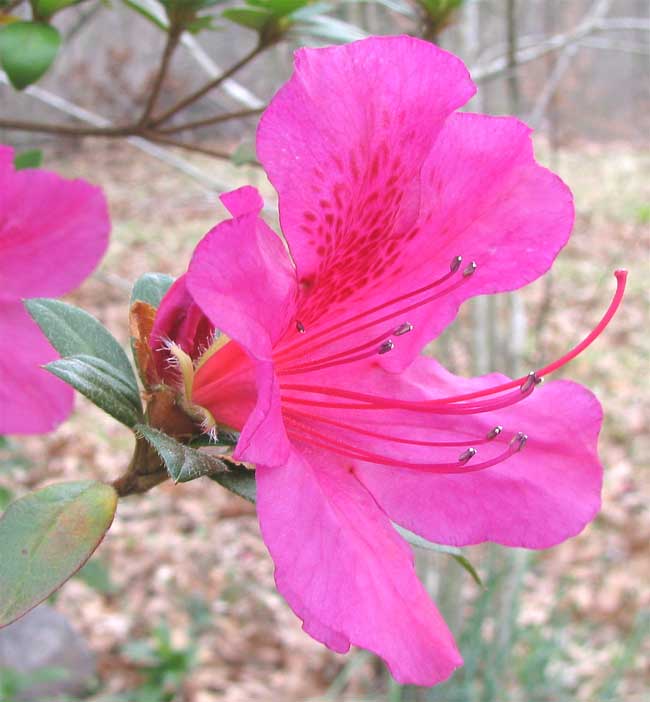Excerpts from Jim Conrad's
Naturalist Newsletter

from the the March 2, 2009 Newsletter, issued from the forest near Natchez, Mississippi; elevation ~400ft (120m), ~N31.47°, ~W91.29°:
AZALEAS FLOWERING
Karen's azaleas are flowering, as you can see above. That particular plant stands right outside my computering window so you can imagine how frequently during the day I rest my eyes on it.
As often is the case, once you start paying attention to the world of azaleas, you get drawn into it. It's such a huge and esthetically pleasing world that some people specialize in azaleas, like some birders just are interested in wood warblers.
In the picture you can plainly make out the flower's ten purple-anthered, pink-filamented stamens, and the longer, more curving, pink, stigma-topped style arising amongst them.
Azaleas belong to the genus Rhododendron, of which about 1000 species are recognized, mostly native to temperate regions of the Northern Hemisphere. North America has 16 native azalea species, mostly in the Southeast. Most azaleas bought at garden centers are not native species, but hybrids developed from various, frequently Asian species.
Karen THINKS that the azalea in the picture is horticulturally known as "Pride of Mobile," but she provided that name with trepidation because Garden Club ladies around Natchez take these matters seriously. "Pride of Mobile" is the exact "old-time" azalea species that must be grown around your antebellum mansion if you want everything to be historically accurate, and the Garden Club ladies do.
On the Internet I find that "Pride of Mobile" is one of several cultivars of the "Southern Indian Hybrid" group, also known collectively as the "Indica Azalea, Rhododendron x Indica. I read that Indica Azaleas were "developed from a large collection of Belgian Indian hybrids in the Southeastern US around 1870. It is a mixed group, including forms and hybrids of R. indicum X R. simsii and 'Mucronatum' forms X R. indicum."
Using Bailey's Manual of Horticultural Plants I key out Karen's azalea to the general vicinity of that cluster of species, though her plant doesn't fit any of the species descriptions perfectly. When I search for photos of "Pride of Mobile" on the Internet flowers of various shades turn up, some with five stamens and some with ten, but all looking more or less like Karen's plant.
I suspect that around Natchez's mansions nowadays there's a variety of "Southern Indian Hybrids" with varying pedigrees and varying numbers of stamens, all being called "Pride of Mobile," and really there's not much use debating what's the "pure 'Pride of Mobile.'" By now the genes are too scrambled to be dogmatic about it.
If you'd like to get addicted to azaleas, browse through the Azalea Society of America's website at http://www.azaleas.org/index.pl/azaleas.html.